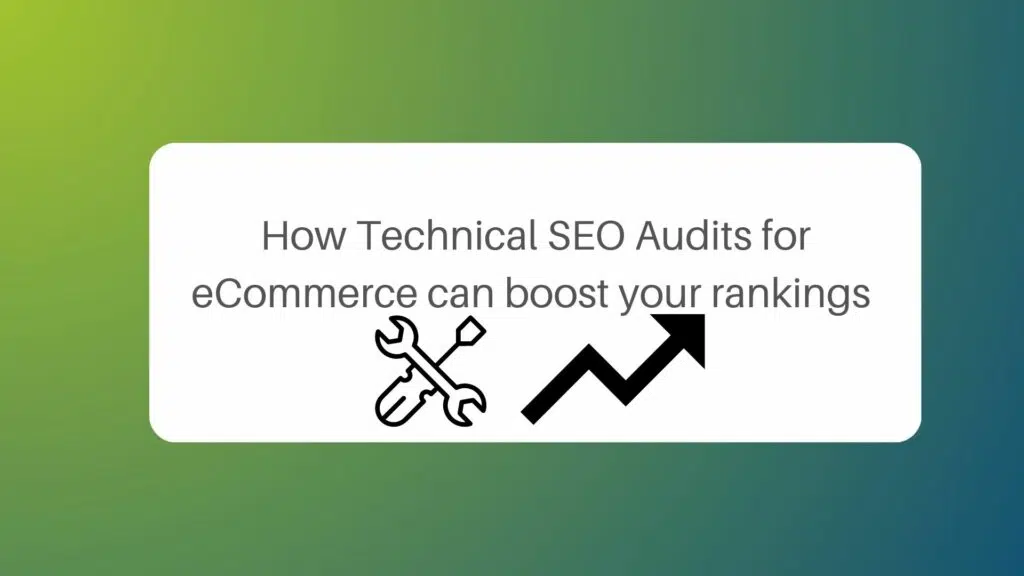This post is part of the Top SEO Strategies for eCommerce Websites.
Are you finding it challenging to enhance the search engine rankings of your eCommerce website? While there are various factors that can influence your rankings, one crucial aspect that website owners often overlook is conducting technical SEO audits.
Technical SEO audits play a significant role in improving your rankings and optimizing the backend of your eCommerce website. By focusing on the structure, speed, and performance of your website, you can enhance its visibility and attract more traffic.
In this blog post, we will delve into the importance of technical SEO audits for eCommerce websites. We will explore how these audits can effectively boost your rankings and provide expert tips to help you optimize your website. By harnessing the power of technical SEO, you can gain a competitive edge and drive substantial organic traffic to your eCommerce site.
eCommerce SEO Audits: What are they, and what should they include?
A technical SEO audit for eCommerce specifically focuses on evaluating and optimizing the technical aspects of an eCommerce website to enhance its search engine visibility. This type of audit examines various factors that affect crawling, indexing, and ranking by search engines.
During a technical SEO audit, several elements are assessed to identify any issues that might be impacting the website’s performance. These elements include website speed, mobile responsiveness, site architecture, URL structure, internal linking, and metadata. The audit may also involve analyzing the website’s code, such as HTML and JavaScript, to pinpoint any errors or problems that could be negatively affecting its SEO performance.
The primary objective of conducting a technical SEO audit for eCommerce sites is to uncover any technical issues that might be preventing the website from achieving high rankings in search engine results pages (SERPs). Once these issues are identified, the website owner or marketer can take appropriate actions to rectify them. By addressing these issues, the website’s search engine visibility can be improved, leading to increased organic traffic and better overall performance.
What are the 5 Cs of Technical SEO Audits?
Crawlability: This refers to the ability of search engines to crawl and index your website. A technical SEO audit should ensure that your site is crawlable by search engines and that there are no technical barriers that prevent search engines from accessing your site.
Content: This refers to the content on your website. A technical SEO audit should ensure that your content is optimised for search engines and that there is no duplicate content, thin content, or keyword stuffing.
Code: This refers to the HTML code that makes up your website. A technical SEO audit should ensure that your code is clean and free of errors and that it is optimised for search engines.
Configuration: This refers to the technical settings and configuration of your website. A technical SEO audit should ensure that your website is properly configured with sitemaps, robots.txt files, and structured data markup.
Connectivity: This refers to the links on your website, both internal and external. A technical SEO audit should ensure that your links are properly structured and that there are no broken links, redirect chains, or other connectivity issues.
What should a Technical SEO Audit for eCommerce Include?
A technical SEO audit for eCommerce should focus on evaluating the website’s technical optimization in a manner that is specifically tailored to the unique requirements of eCommerce websites. Here are some crucial areas that should be included in an eCommerce technical SEO audit:
- Website Speed: Assess the loading speed of the website’s pages, as slow-loading pages can negatively impact user experience and search engine rankings.
- Mobile Responsiveness: Check if the website is optimized for mobile devices, ensuring that it provides a seamless and user-friendly experience across different screen sizes.
- Site Architecture: Evaluate the website’s structure and organization, ensuring it is logical, user-friendly, and allows search engines to crawl and index the pages effectively.
- URL Structure: Review the URLs used on the website, making sure they are descriptive, concise, and include relevant keywords where applicable.
- Internal Linking: Analyze the internal linking structure of the website, ensuring that it is well-structured, facilitates easy navigation, and helps distribute link authority throughout the site.
- Metadata: Examine the meta titles and descriptions used on the website, ensuring they are optimized, relevant, and compelling for both users and search engines.
- Schema Markup: Check if the website utilizes schema markup to provide search engines with additional information about the products and content, enhancing visibility in search results.
- Site Security: Verify that the website has proper security measures in place, such as SSL certificates, to protect user data and improve trustworthiness.
- Indexing Issues: Identify any potential indexing issues, such as blocked pages or duplicate content, and implement measures to resolve them.
- Technical Errors: Conduct a thorough analysis of the website’s code, including HTML and JavaScript, to identify and fix any technical errors that may hinder search engine crawling and indexing.
By conducting a comprehensive technical SEO audit that addresses these key areas, eCommerce websites can optimize their technical infrastructure, enhance user experience, and improve search engine visibility, ultimately leading to increased organic traffic and higher rankings in search results.
Core Web Vitals and Site Speed:
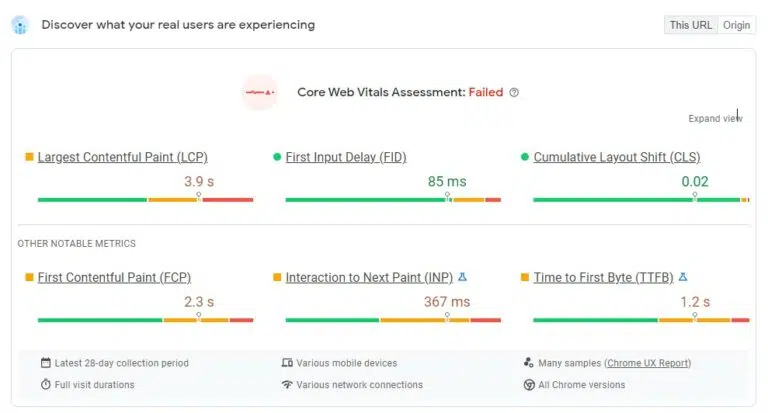
Core Web Vitals are a set of metrics that evaluate website speed, responsiveness, and overall user experience. As of 2021, Core Web Vitals have become a crucial factor for SEO, and eCommerce websites are no exception. The audit should evaluate the website’s Core Web Vitals, including factors such as loading speed, interactivity, and visual stability, and identify any issues that may be negatively impacting search engine rankings. Improving Core Web Vitals can lead to better user experience, higher engagement, and ultimately, improved search engine rankings.
The website’s loading speed should be evaluated to ensure it meets the expectations of modern users and search engines. Slow loading speeds can negatively impact user experience and search engine rankings, so it’s important to identify any speed-related issues and take action to fix them.
To view your site’s Pages Speed and CWV, you can either try PageSpeed Insights or if you already have Google Search Console set up for your site (which is a must for any site owner.) You can view you’re Page Speed and CWV audit in the left-hand menu.
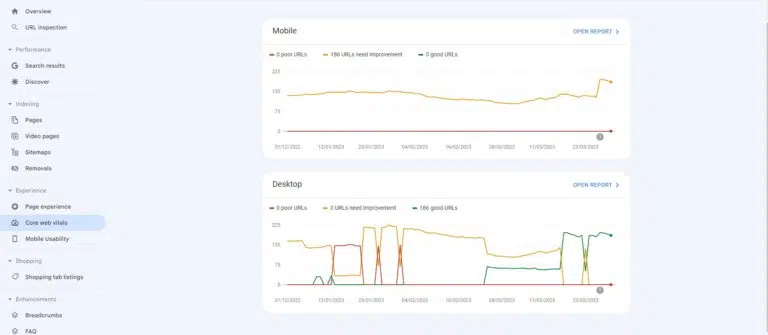
Mobile Responsiveness:
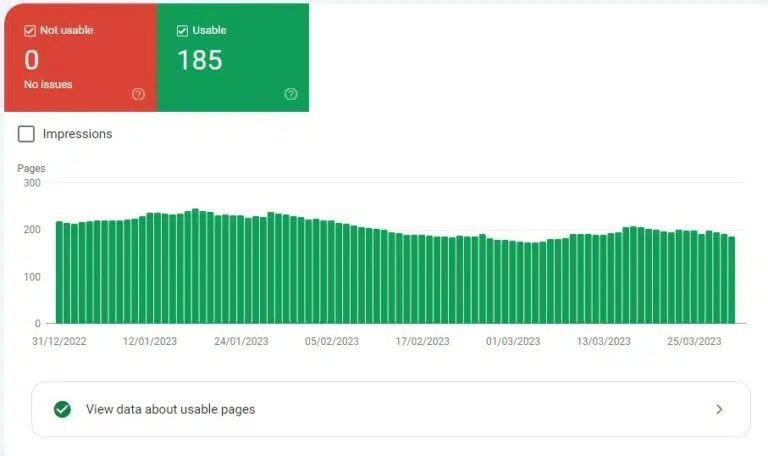
In today’s digital landscape, the significance of mobile responsiveness for SEO cannot be overstated. With a growing number of users accessing the internet through mobile devices, it is essential to evaluate the website’s mobile responsiveness during an SEO audit to ensure it aligns with the expectations of modern search engines.
During the audit, the mobile responsiveness of the website should be thoroughly assessed. This involves examining how the website renders and functions on various mobile devices with different screen sizes and orientations. The goal is to ensure that the website provides a seamless and optimized browsing experience for mobile users.
Key elements to evaluate in terms of mobile responsiveness include:
- Page Layout: Analyze how the website’s layout adapts to different screen sizes, ensuring that the content remains visually appealing and readable on mobile devices without the need for excessive zooming or scrolling.
- Navigation: Check the website’s navigation menus and buttons to ensure they are easily accessible and user-friendly on mobile devices. Mobile users should be able to navigate the website effortlessly and find the desired information or products without frustration.
- Touchscreen Compatibility: Evaluate the website’s interactive elements, such as buttons, forms, and dropdown menus, to ensure they are optimized for touchscreen interaction. Buttons should be appropriately sized and spaced to accommodate touch gestures accurately.
- Loading Speed: Assess the loading speed of the website on mobile devices, as slow loading times can lead to high bounce rates and negatively impact user experience. Optimize images, minimize server requests, and leverage caching techniques to improve mobile loading speed.
- Content Display: Examine how the website’s content, including text, images, and videos, is displayed on mobile devices. Ensure that the content is appropriately scaled, and media files are optimized for efficient mobile delivery.
Site Architecture:
The site architecture should be evaluated to ensure it’s organized in a way that’s easy for search engines to crawl and index. This includes evaluating factors such as internal linking, URL structure, and the use of header tags.
Schema Markup:

Schema markup plays a crucial role in helping search engines understand the content and context of an eCommerce website, enabling better visibility and ranking for relevant keywords. Therefore, during an SEO audit, it is essential to evaluate the website’s implementation of schema markup via a validator and identify any opportunities for improvement.
The audit should assess the website’s use of schema markup by examining the following aspects:
- Presence of Schema Markup: Determine whether the website has implemented schema markup throughout its pages. Schema markup can be applied to various elements, such as product listings, reviews, ratings, pricing, and availability.
- Correct Schema Types: Ensure that the appropriate schema types are used for different types of content on the eCommerce site. For example, product schema for individual products, aggregate rating schema for reviews and ratings, and organization schema for company information.
- Accuracy of Schema Implementation: Verify that the schema markup is implemented accurately and adheres to the guidelines provided by Schema.org. This includes properly defining properties, values, and nesting of schema markup elements.
- Validating Schema Markup: Utilize the Schema.org validator or other relevant tools to validate the implemented schema markup. This helps ensure that the markup is correctly structured and that search engines can understand and interpret it effectively.
- Opportunities for Expansion: Identify potential areas where additional schema markup can be applied to enhance the visibility of specific content, such as events, videos, recipes, or FAQs. This can provide more detailed information to search engines and potentially increase the website’s presence in relevant search results.
Indexing Issues:
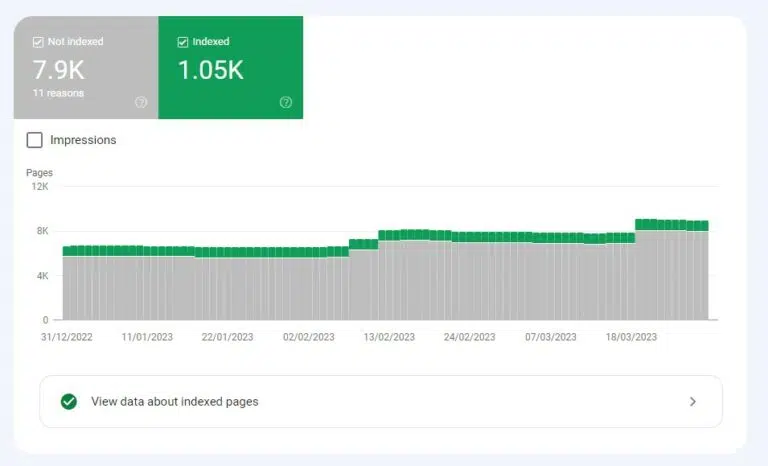
Indexing issues, such as duplicate content and missing meta tags, can negatively impact search engine rankings. The audit should evaluate the website for any indexing issues and provide recommendations for how to fix them.
Google Search Console makes it really easy for eCommerce site owners to view which of their pages are or aren’t being indexed, they also help owners to understand why their pages may not be indexed with a variety of potential issues, as seen in the image below:
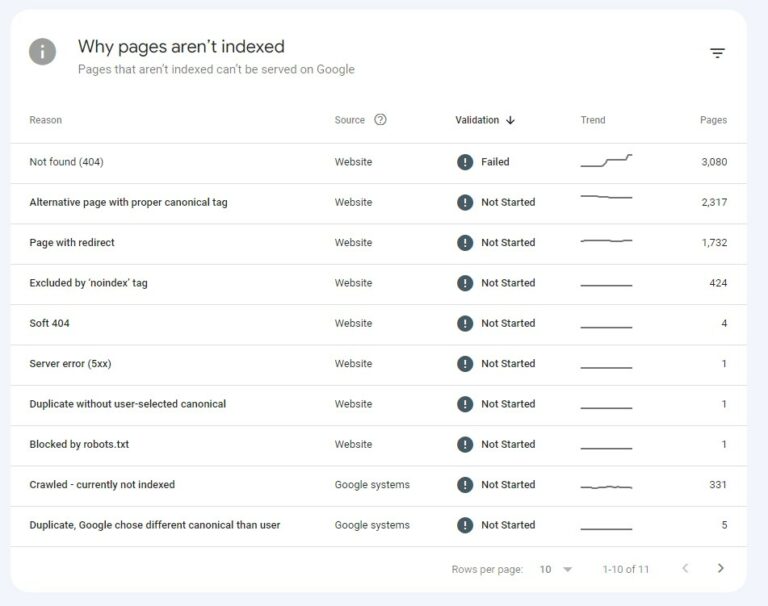
Product Page Optimisation:
The optimization of product pages is crucial for eCommerce websites. The audit should evaluate the optimization of product pages, including factors such as title tags, meta descriptions, and product descriptions, to ensure they’re optimized for relevant keywords and provide a great user experience.
For a comprehensive understanding of optimizing product pages for eCommerce, we recommend exploring the article titled “How to Improve eCommerce Product Page SEO.” This resource delves into the intricacies of enhancing SEO for product pages, providing valuable insights and practical tips.
In this article, you will discover various strategies and techniques to optimize your eCommerce product pages for improved search engine visibility and user engagement. It covers a range of topics including keyword research, product descriptions, title tags, image optimization, user-generated content, and the importance of mobile responsiveness. By implementing the recommendations outlined in the article, you can enhance your product pages’ SEO performance and drive more organic traffic to your eCommerce site.
What tools can help to build a technical SEO Audit for eCommerce?
Gathering all of the data we have spoken about in this blog, can seem quite overwhelming at first to any eCommerce site owner, who has never conducted a technical site audit. But lucky for you we have gather a list of different online tools and platforms to make your lives easier.
Screaming Frog:
Screaming Frog is a tool that crawls your website and provides a detailed report of technical SEO issues, such as broken links, missing meta tags, and duplicate content. It is a paid tool but offers a free version with limited features.
SEMrush:
SEMrush is a comprehensive SEO tool that offers a range of features, including a site audit tool. This tool can identify technical SEO issues such as crawl errors, broken links, and duplicate content. It also provides actionable recommendations for fixing these issues.
Ahrefs:
Ahrefs is another popular SEO tool that offers a site audit feature. This tool can help you identify technical SEO issues, such as broken links, duplicate content, and missing meta tags. It also provides recommendations for fixing these issues.
Google Search Console:
Google Search Console is a valuable free tool offered by Google, designed to assist website owners in identifying and resolving technical SEO issues. By utilizing this tool, you can gain insights into various aspects of your website’s performance and make informed decisions to improve its visibility in search results.
GTmetrix:
GTmetrix is an invaluable tool for analyzing the speed and performance of your website. By utilizing this tool, you can identify and address issues that may be negatively impacting your site’s load time. Improving your website’s speed not only enhances user experience but also positively affects your SEO efforts.
Moz Pro:
Moz Pro is a comprehensive SEO tool that includes a site audit feature. This tool can help you identify technical SEO issues, such as crawl errors, broken links, and duplicate content. It also provides recommendations for fixing these issues.
These tools can provide valuable insights into technical SEO issues on your eCommerce site, and help you prioritize which issues to fix first.
We appreciate you taking the time to read our blog post How Technical SEO Audits for eCommerce can boost your rankings. We trust that you have found the information to be useful and informative in enhancing your eCommerce site’s SEO performance.
Should you have any inquiries or require further information on how our eCommerce services can assist in expanding your business, please feel free to leave a comment below or contact us directly.
Tillison Consulting has a team of specialists who offer diverse eCommerce services for various platforms through our eCommerce digital marketing agency. These services include but are not limited to, SEO for eCommerce, Google Shopping, CRO for eCommerce, and others. Let us help you take your eCommerce business to the next level.

